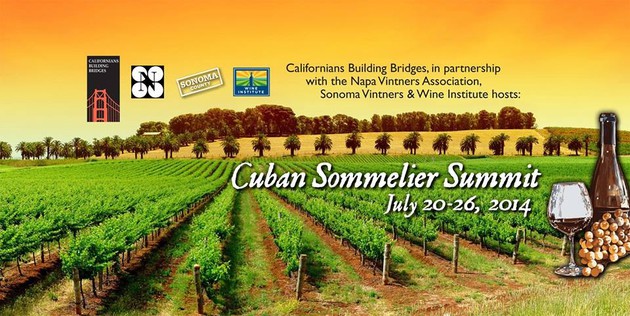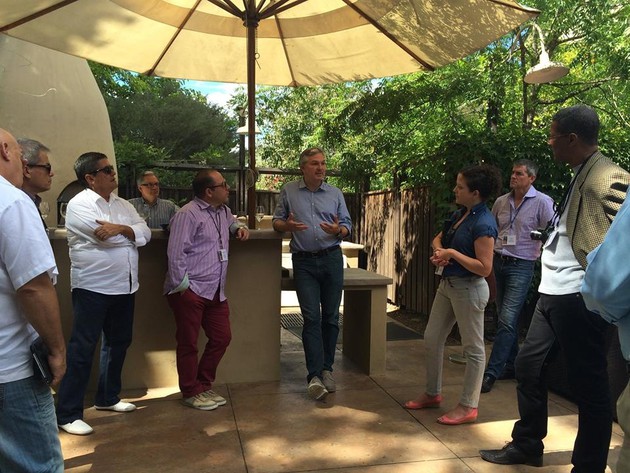Californian wineries look to make use of a trade loophole and build exports to Cuba
From this side of the Atlantic relations between Cuba and the United States would hardly be described as friendly. But, as Katherine Canfield, explains there is far more bridge building going on than you might think. Here she looks at how the Californian wine industry is looking to promote its wines to the Cuban wine trade.
 Cuban Sommelier Summit20 Cuban sommeliers travelled to Calfornia last week as part of a bid to educate themselves in Californian wine
Cuban Sommelier Summit20 Cuban sommeliers travelled to Calfornia last week as part of a bid to educate themselves in Californian wine
The Californian wine industry is looking to build relationships with the Cuban hospitality and restaurant sector as it looks to make the most of a loophole that exludes wine from the trade embargo between the US and Cuba.
Last week 20 Cuban nationals got a thorough look into the California wine industry thanks to the Californians Building Bridges' (CBB) inaugural Cuban Sommelier Summit.
CBB is a non-profit group dedicated to building Cuban-US relations through humanitarian and cultural exchanges, and helped host the six-day tour with the California Wine Institute, Napa Valley Vintners and Sonoma County Vintners. This was the first event of its kind aimed at educating the elite of Cuba's sommelier trade about California wines.
Of the 20 sommeliers, only two had previously travelled to the US, and though most of them were well versed in the wines of the world, they had very little direct experience with Californian wines. "There is almost no presence of US wine in Cuba and none recorded in our export report for 2013," said Gladys Horiuchi, a spokeswoman for the California Wine Institute. CBB founder Darius Anderson added: "The reality is, the majority of wines in Cuba are from Argentina or Chile or Spain, and there are very few California wines. Most of them are just not educated on California wines, because they can't come here."
Though California wine is a rarity in the Cuban market, it is not totally unknown. One of the participating wineries in the event, Wente Vineyards is among the few that boast a presence in Cuba. They began exporting 200 to 300 bottles last year - a low figure when compared to the 100,000 cases they exported to 70 countries around the world.
"We've made a relationship with an importer there that deals with all of the top restaurants and hotels. That is why this group is of particular importance to us," said Michael Parr, Wente's vice president of international sales.
The California wine industry's current situation is in part due to the long-standing trade embargo between the US and Cuba. Pharmaceutical and agricultural products - wine included - are exempt from trade restrictions, but those wishing to find distribution in Cuba face many obstacles. "Today, the export of US wines into Cuba does not violate federal trade policies toward Cuba, but it has to be conducted in full compliance with US and international law," said Holly Fraumeni, executive director of CBB. "It is very challenging and difficult for agricultural producers. Even if you can get permission granted, the logistics of getting it there is one of the most challenging pieces of the puzzle."
 Californian winery, Seghesio, hosts the Cuban partyThe Californian study tour included a trip to the Seghesio winery
Californian winery, Seghesio, hosts the Cuban partyThe Californian study tour included a trip to the Seghesio winery
There was hope among the sommeliers, wineries and organisers that these challenges will subside in the near future and California wine will come to higher prominence in Cuba. Anderson viewed this event as an opportune moment to strengthen California-Cuba agricultural trade and business relations. "The intent is to drive sales," he said. "It is a great opportunity to expand the California wine reach."
This may be true as Cuba now boasts more than 250 sommeliers in the country, half of whom are women, and wine is becoming more intertwined with Cuban culture, which was previously limited to associations with rum and cigars. "This is a great opportunity for us to get to know, understand and appreciate California wines so we can be in a position to both recommend and help promote them in our country," said Fernando Fernandez. Osiris Orama, general manager of La Barca Restaurant in Havana, Cuba, agreed. "Very soon we want to get this wine in Cuba to offer to customers," he said.
Whilst many of the Cuban participants were impressed by the quality and the wide variety of styles of the wines they tasted in both Napa and Sonoma counties, it was the exposure to new perspectives on food and wine pairing that expanded their view of the Californian wine industry. From chocolate and wine pairing at Sebastiani Vineyards and Winery in Sonoma County to a multi-course lunch at Silver Oak Winery in Napa Valley, the sommeliers tasted and paired some of the best of what California wine and agriculture has to offer. Wine and food pairing dinners were also set at Buena Vista Winery, Beringer Winery and Napa Valley Country Club with Michael Mondavi.
Juan Machin Gonzalez, maître d' of the historic Presidente Hotel in Havana, was very positive at the culmination of the trip. "We can get for the first time the expression of Sonoma/Napa wine and their culture. We have read about it, but it's not the same as to live the experience," he said.




